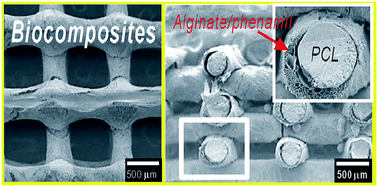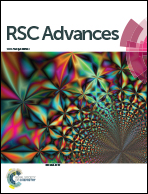3D-printed alginate/phenamil composite scaffolds constituted with microsized core–shell struts for hard tissue regeneration†
Abstract
Three-dimensional (3D) biomedical scaffolds that are physically and mechanically similar to regenerated tissues and provide bioactive sites for cultured cell adhesion, growth, and even differentiation have been used widely in various tissue regenerative materials. In this work, we propose new composite scaffolds consisting of poly(ε-caprolactone) (PCL), alginate, and phenamil methanesulfonate (PM), manufactured by a combined process involving 3D plotting together with a low-temperature working plate and a versatile coating process. The composite scaffolds consist of microsized struts with a core (PCL)–shell (alginate/PM) structure. The PCL in the micro-sized struts has the function of providing mechanical support to the scaffold, and the shell region (alginate/phenamil) is used as a biologically active material. PM is known to stimulate osteoblastic differentiation and mineralization. However, phenamil cannot be used easily as a biomedical scaffold material because of its low molecular weight and low processability. We first introduced the bioactive component, PM, in a solid-freeform fabricated multi-layered pore structure. To assess the effects of PM, the biocompatibility of the composite scaffolds for bone tissue regeneration was characterized in vitro using preosteoblasts (MC3T3-E1 cells). Cells were distributed more extensively and proliferated to a greater degree on the PCL/alginate–PM scaffold in a limited PM concentration range versus the PCL/alginate scaffold. Specifically, cell viability and ALP activity were high in a composite scaffold containing PM at 3.5 μg, but not higher PM levels (PM: 5.6 μg per scaffold), compared with PCL/alginate scaffolds. These results suggest that the multi-layered PCL/alginate–PM scaffold may be a promising bioactive material for enhancing bone tissue growth, but over a limited range of PM levels.


 Please wait while we load your content...
Please wait while we load your content...